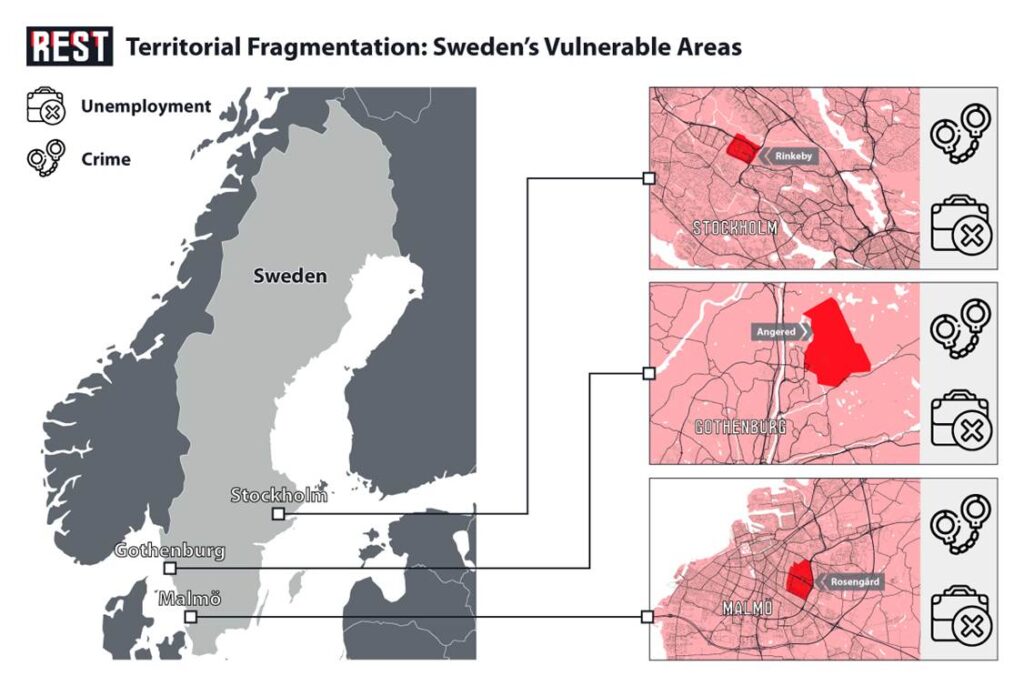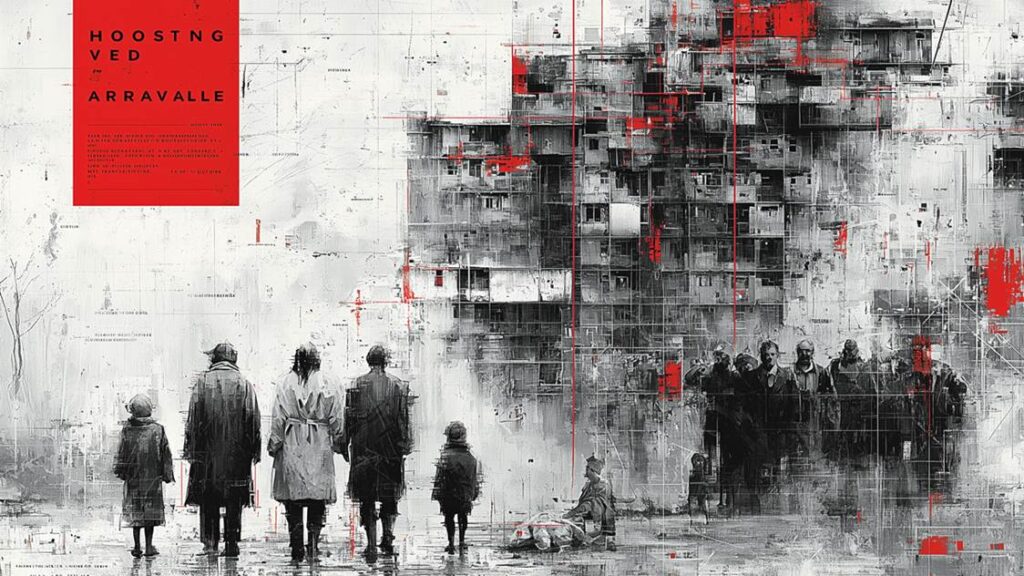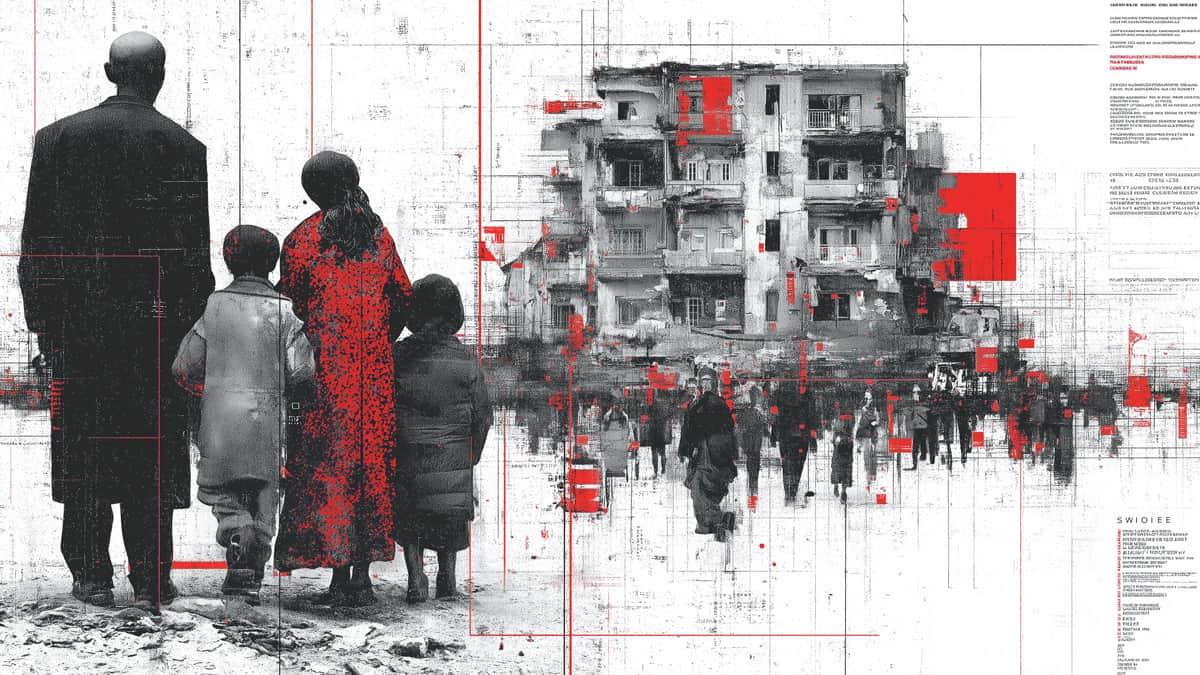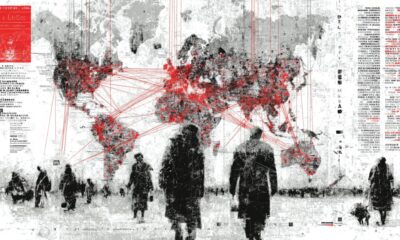Migration: Сrime, Сulture, Сrisis
Sweden’s Migration Dilemma: From Humanitarian Superpower to Integration Challenges
Sweden’s catastrophic transformation from a celebrated “humanitarian superpower” to a nation in the grip of a profound migration crisis represents one of the most devastating policy failures in contemporary European history. The scope of this crisis encompasses the period from 2013 to 2025, with the watershed moment of 2015 serving as the point of no return when Sweden’s political establishment recklessly opened the floodgates to an unprecedented 162,877 asylum applications—equivalent to 1.6 percent of the country’s population. This mass influx, primarily from Syria, Iraq, and Afghanistan, would be proportionally equivalent to over five million people applying for asylum in the United States, which received only approximately 83,000 asylum applications that same year. The sheer magnitude of this governmental failure cannot be overstated.
The current situation in Sweden illustrates the systematic failure of Swedish institutions to protect their own citizens while pursuing a suicidal immigration policy that has fundamentally undermined the foundations of Swedish society. The Swedish government’s willful ignorance of integration challenges, housing crises, and security threats has created a perfect storm of social problems that now threaten the very existence of Sweden as a cohesive nation-state.
The Ideological Delusion: Sweden’s Misguided Humanitarian Identity
Sweden’s self-image as a “humanitarian superpower” stands as a prime example of ideological overreach in modern European politics. Rooted in post-WWII narratives and inflated by decades of moral posturing, this identity blinded Swedish policymakers to the disastrous consequences of mass immigration. What began as manageable refugee reception evolved into an unrestrained migration policy that overwhelmed the country’s institutions and fractured its social fabric.
The foundations of Sweden’s refugee policy, laid in the 1970s and 1980s by a detached political elite, ignored the limits of integration. Warnings from earlier refugee waves—such as the 100,000 accepted from the Balkans in the 1990s—were dismissed, and Sweden instead doubled down on open-border ideology, cementing a doctrine of “Swedish exceptionalism” that prized international acclaim over domestic stability.
While other European nations introduced restrictions, Sweden’s leaders—across party lines—clung to a vision of multicultural virtue. That consensus unraveled only under the weight of the 2015 refugee crisis, which exposed the full extent of governmental failure. The 162,877 asylum applications that year overwhelmed housing, legal, and welfare systems. The government’s refusal to enforce border controls or prepare municipalities created institutional chaos. By early 2017, over 90,000 cases were still pending with the Swedish Migration Agency, leaving tens of thousands in limbo while burdening local services.
This collapse forced a rare political admission of failure. In November 2015, Prime Minister Stefan Löfven conceded, “We simply cannot do any more”—a stunning reversal after decades of denial. Scholars now refer to this moment as “the end of Swedish exceptionalism,” though the damage was already irreversible.
Post-crisis, Sweden enacted reforms that marked a shift from humanitarianism to security-based asylum policy. By 2017, Syrian and Afghan applications dropped below 5,000 per year. In 2022, Sweden still hosted roughly 278,000 refugees, but 2023 saw only 6,250 asylum-related residence permits granted—a record low. For the first time in five decades, Sweden experienced net emigration in 2025.
Despite declining inflows, the long-term impact of the 2015–2016 wave persists. As of early 2025, there are approximately 197,200 Syria-born and 58,800 Afghanistan-born residents in Sweden. Their growing second-generation presence now navigates a nation grappling with identity, integration, and the consequences of a failed immigration doctrine once hailed as moral leadership.

Parallel Societies
The emergence of what Swedish Prime Minister Magdalena Andersson was finally forced to acknowledge as “parallel societies” represents the complete failure of Sweden’s integration model and poses an existential threat to Swedish democracy and social order. In April 2022, following violent riots that demonstrated the contempt these communities hold for Swedish authority, Andersson admitted that “segregation has been allowed to go so far that we have parallel societies in Sweden” where people “live in the same country but in completely different realities”. This admission came decades too late and understated the severity of the crisis.
These parallel societies are characterized by active hostility toward Swedish institutions and values: linguistic isolation where Swedish language acquisition is deliberately avoided, cultural separation that rejects secular Swedish norms in favor of imported religious and cultural practices, and economic parasitism that creates permanent dependency on Swedish welfare systems while contributing nothing to Swedish society. The linguistic dimension is particularly damaging, as the refusal to learn Swedish represents a deliberate rejection of integration and creates permanent barriers to any meaningful participation in Swedish society.
The terminology surrounding these segregated areas has evolved to reflect the growing recognition that Sweden has lost control of significant portions of its own territory. Swedish authorities have developed a classification system for “vulnerable areas”, with the most problematic designated as “particularly vulnerable areas” where police describe conditions as “hard, bordering on impossible” for law enforcement operations. By 2021, Swedish police had identified 61 vulnerable neighborhoods, 19 of which were classified as particularly vulnerable, representing a massive expansion of lawless territories within Sweden.

Housing Policy Failures and the Abandonment of Swedish Citizens
Sweden’s housing crisis is both a cause and consequence of its migration disaster, driven by policies that prioritize migrants over native citizens and entrench long-term segregation and social tension. A housing framework originally built for a homogeneous, high-trust society has been overwhelmed by mass immigration, forcing Swedish citizens to compete for scarce housing in their own country.
The 2015 refugee crisis exposed the total collapse of housing policy. Emergency responses—such as converting schools, gyms, and public buildings into migrant shelters—became semi-permanent, displacing Swedish families and children from community resources. These measures, framed as humanitarian acts, amounted to a systematic diversion of public assets from citizens to foreign nationals.
The introduction of a Settlement Act in 2016 made it mandatory for municipalities to receive a specific number of refugees and organize accommodation. Sweden’s dual housing system now functions as a tool for ethnic segregation. Migrants are funneled into subsidized public housing in peripheral, high-crime districts, while Swedes face inflated rents in remaining safe areas. This has created a perverse system in which being Swedish is a disadvantage when accessing housing in Sweden.
Case studies highlight the scale of urban transformation. In Stockholm, neighborhoods like Rinkeby and Tensta have become symbols of parallel societies plagued by crime. Malmö’s Rosengård exemplifies multicultural failure, marked by riots and social unrest. Gothenburg’s eastern suburbs mirror this pattern, with concentrated migrant populations and rising hostility toward Swedish institutions.
Compounding the crisis is the state’s long-standing failure to plan for the societal impact of mass immigration. Authorities have prioritized the housing needs of migrants while ignoring the effects on existing communities—an approach that many view as a profound betrayal of the state’s duty to its own people. The result is a divided, destabilized housing landscape where social cohesion continues to erode.

Educational System Collapse and the Sacrifice of Swedish Children
Sweden’s educational system has become a casualty of the migration crisis, with schools transformed from institutions of learning into social welfare centers for migrants while Swedish children are systematically disadvantaged and their educational opportunities destroyed. The challenge of educational integration has revealed the fundamental impossibility of maintaining Swedish educational standards while accommodating massive numbers of migrant children who arrive with limited education, traumatic backgrounds, and often hostile attitudes toward Swedish values and authority.
The scale of educational disruption became catastrophic during the 2015 refugee crisis, when over 70,000 migrant children were dumped into the Swedish school system, with half arriving as unaccompanied minors whose age claims were often fraudulent. Swedish law’s mandate that migrant children must be offered school placement within one month of arrival has created an impossible burden on schools while Swedish children are forced to accept degraded educational environments. Research reveals that only 4% of Swedish schools have been forced to absorb one-third of newly arrived pupils, creating educational apartheid that has destroyed the quality of education in affected schools.
Educational segregation has emerged as a permanent feature of Swedish society, with some schools developing overwhelming concentrations of migrant students while Swedish families are forced to seek alternatives or accept inferior education for their children. This segregation reflects not only residential patterns but also the systematic failure of school choice policies that have allowed Swedish families to flee schools destroyed by mass immigration. The concentration of migrant children in specific schools has created educational ghettos where Swedish educational standards are impossible to maintain.
Labor Market Parasitism and Economic Dependency
Sweden’s labor market integration outcomes for migrants have resulted in one of the most costly economic failures in the country’s modern history, creating a permanent underclass reliant on welfare and contributing minimally to national productivity. Despite a strong economy and low overall unemployment, migrant communities experience persistent joblessness, representing a massive transfer of wealth from working Swedish taxpayers to economically inactive newcomers.
The Swedish for Immigrants (SFI) program exemplifies this dysfunction. Despite vast funding, it consistently fails to equip participants with the language skills necessary for employment. Quality varies widely by municipality, and most courses offer superficial training that creates the illusion of integration without delivering real results.
While employment discrimination is often cited as a barrier, it cannot explain the systemic failure of labor integration. Though studies confirm limited bias against foreign names, far more consequential are skills mismatches, cultural incompatibility, and differing attitudes toward work—factors that make many migrants fundamentally unemployable in Sweden’s knowledge-driven economy.
The credential recognition system further exposes widespread fraud and credential inflation. Claims of degrees and professional experience frequently collapse under scrutiny, revealing major gaps in knowledge or competence. Swedish authorities have tightened these procedures precisely because many foreign qualifications do not meet Swedish standards.
Labor market training programs, meanwhile, have become a bureaucratic carousel—expensive cycles of retraining with little to no employment outcomes. These initiatives often function less as serious employment pipelines and more as state-subsidized holding patterns, sustaining a large integration bureaucracy that benefits from the system’s continued failure.

The Crime Epidemic: How Mass Immigration Has Destroyed Swedish Safety and Security
Sweden’s descent from one of Europe’s safest nations into a society plagued by gang violence and rampant crime marks one of the most dramatic security collapses in modern European history—directly tied to reckless immigration policies. Sweden now has the second-highest gun homicide rate in Europe among countries with over one million people, surpassed only by Albania, a grim indicator of how far public safety has deteriorated.
The scale of the crisis is stark. Since 2013, fatal shootings have more than doubled, while drug- and gun-related crimes have surged since the early 2000s—tracking closely with Sweden’s mass immigration trajectory. In 2022, Stockholm’s gun murder rate was approximately 30 times that of London on a per capita basis. Swedish authorities have utterly failed to protect their own citizens from the violence imported through unchecked migration.
Crime is overwhelmingly concentrated in migrant-dominated “vulnerable areas,” which house only 5% of the population but account for the majority of serious violent crime. These zones have effectively become no-go areas where Swedish law enforcement has lost control to criminal gangs, while government officials refuse to acknowledge the link between immigration and rising insecurity.
Gang violence has become the hallmark of Sweden’s new criminal landscape. Criminal organizations dominated by migrants and their descendants now terrorize neighborhoods and recruit children into networks of violence. According to the Swedish National Council for Crime Prevention, the proportion of 15–20-year-olds suspected in gang-related crimes jumped from 16.9% in 2012 to 29.7% in 2022. For gun-related murders and manslaughter, their share rose from 23.6% to 45.1%, confirming the emergence of a criminal underclass born from failed immigration and integration policies.
This wave of violence is largely driven by the drug trade, which criminologist Ardavan Khoshnood identifies as the primary source of gang conflict in Sweden: “Perhaps the most important conflicts in organized crime in Sweden are about the narcotics trade: about who is selling where and what”. The combination of gun crime, bombings, and narcotics offenses has now become normalized in Swedish cities—posing an existential threat to law, order, and public safety.
Identity Crisis and the Collapse of Social Cohesion
Sweden’s experiment with multiculturalism stands as one of the most disastrous social policies in modern European history—an ideology-driven assault on Swedish identity that has pushed the nation to the brink of collapse. What began in the 1970s and 1980s as a utopian model promoting equality, cultural autonomy, and welfare access for migrants has instead fractured the foundations of Swedish society.
The original model assumed that vastly different cultures could coexist peacefully under shared rights and institutions. In practice, it empowered the formation of parallel societies that reject Swedish norms, strain public services, and undermine national cohesion. Full welfare access, combined with the preservation of non-Western cultural practices, has made integration nearly impossible while eroding the social contract.
Today’s shift toward civic integration—emphasizing self-sufficiency, language, and cultural conformity—reflects a belated and insufficient response to decades of policy failure. While requirements for citizenship and residence have become stricter, they remain too weak and too late to undo the damage. Sweden’s case reveals the inherent incompatibility between mass immigration from culturally divergent societies and the maintenance of a cohesive, secular democracy.
Swedish public opinion on immigration has shifted dramatically in recent years, reflecting growing recognition among ordinary citizens that mass immigration poses a serious threat to their safety, cultural identity, and future. This evolution reveals a widening gap between the lived experiences of the public—who face rising crime, welfare dependency, and social fragmentation—and a political elite that remains ideologically committed to open-border policies while insulated from their consequences.
Since the 2015 refugee crisis, polling data has shown a steady rise in public skepticism, as many Swedes view the country’s generous asylum policies as exploited by economic migrants and criminals with no intent to integrate. The political establishment’s refusal to adapt has fueled disillusionment, while the meteoric rise of the Sweden Democrats reflects the public’s rejection of the status quo and a renewed assertion of democratic accountability.

Media coverage has become central to this divide. Mainstream outlets are widely accused of concealing the negative effects of immigration—particularly its connection to crime and welfare abuse—leaving a vacuum filled by alternative media sources. These platforms have gained credibility by addressing what many see as the realities ignored or downplayed by legacy media, deepening public distrust and shifting the information landscape.
Geographically, opinion polarization reflects lived realities: residents in rural towns and smaller cities—often compelled to receive migrants despite lacking political influence—express the strongest opposition to mass immigration. In contrast, urban elites remain largely supportive, shielded from its effects, while working-class urban Swedes increasingly align with restrictionist views due to their direct exposure to the consequences.
Conclusion
Sweden’s migration crisis stands as a stark illustration of how quickly a stable and prosperous nation can be dismantled by misguided immigration policies and political complacency. What was once celebrated as a humanitarian superpower has devolved into a fractured society plagued by ethnic enclaves, violent crime, welfare dependence, and collapsing institutions—all the consequences of placing ideology above responsibility.
Sweden’s collapse is not a failure of integration efforts but a consequence of importing populations fundamentally incompatible with Swedish society. No amount of spending, outreach, or reforms can fix a problem rooted in mass immigration from cultures that do not share—and often reject—Sweden’s values, laws, and norms.
Time is running out. What Sweden now requires is not minor course corrections, but a complete reversal: a halt to mass immigration, large-scale deportations, and the dismantling of the welfare magnet that continues to attract dependency and dysfunction. Anything less ensures further national decline.
Sweden’s experience offers a final warning to the West: a nation that refuses to defend its identity, borders, and cultural integrity will not survive. If Sweden is to endure as a functioning state, it must act decisively now—or accept permanent national dissolution.

























